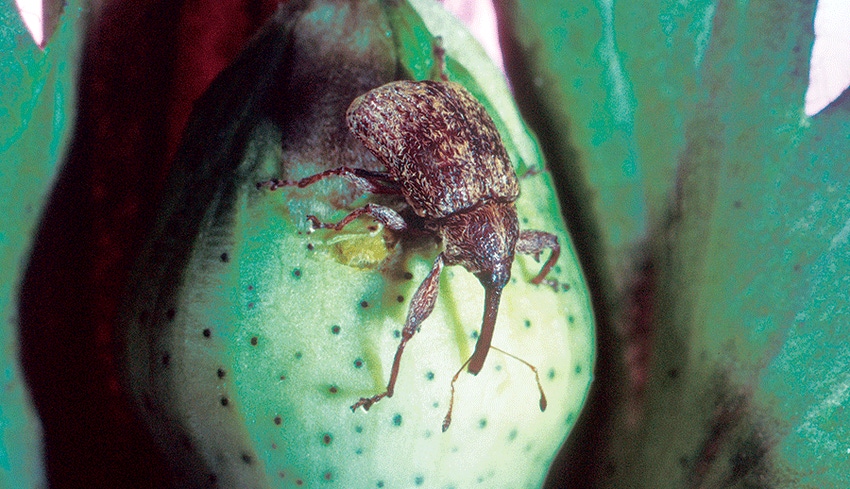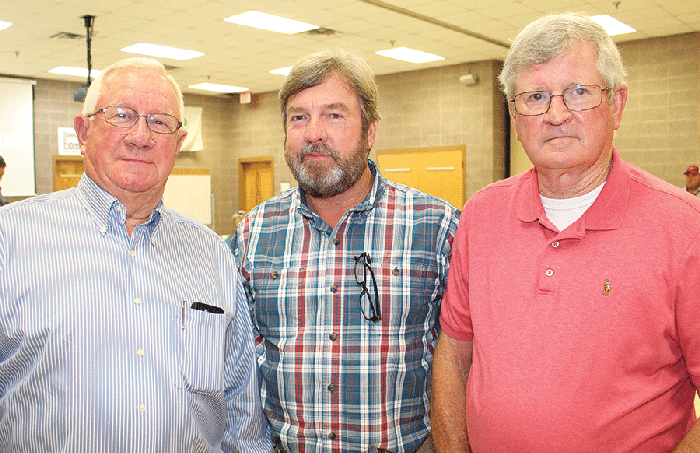
The pest that once cost Mississippi cotton farmers millions of dollars yearly in lost yields, and which they thought could never be conquered, has now been absent from the state’s cotton fields for a decade.
Some of today’s younger cotton farmers have never experienced the destructiveness of the boll weevil that wreaked havoc on U.S. cotton crops for generations.
“We are in our tenth year of being totally boll weevil-free in Mississippi,” Farrell Boyd, program manager for the Mississippi Boll Weevil Management Corporation, reported at the organization’s annual joint meeting with the Mississippi Farm Bureau Federation Cotton Policy Committee.
Farrell Boyd, from left, program manager for the Mississippi Boll Weevil Management Corporation; Buddy Fancher, Greenwood, Miss., producer; and Andy Braswell, Extension agent, Greenwood, Miss.; were among those at the annual joint meeting of the boll weevil management organization and the Mississippi Farm Bureau Federation Cotton Policy Committee.
“Not a single weevil has been captured in traps, and we’ve seen no evidence of any kind to indicate the presence of weevils anywhere in the state.” The eradication program that was launched in 1997 in two regions of Mississippi culminated in 2009 when the pest was declared officially eradicated throughout the state. Since then, the organization has continued a statewide monitoring program using pheromone traps to detect any weevils that might show up in cotton fields.
“It was a long, costly effort,” Boyd says, “but it has been worth millions to cotton producers in Mississippi and across the cotton belt by freeing them from this destructive pest. Mississippi producers who helped finance this program through assessments are to be congratulated for their foresight and determination.” In addition to Mississippi’s weevil-free status, he notes, “We have had eight years of being weevil-free across the entire cotton belt, with the exception of the Rio Grande Valley in south Texas.”
A buffer zone was established in south Texas to help prevent the boll weevil from moving out of Mexico into the U.S., and Mexico has been conducting its own eradication program, with input from the Rio Grande Valley operation, Boyd says.
James Langley, from left, V&M Cotton Company, Yazoo City, Miss.; Taylor Harris, Kosciusko, Miss., producer; and Pat George, TJ Beall Co., Cleveland, Miss., got the latest news on Mississippi’s boll weevil eradication program.
“They’ve made some strides in Mexico, getting things in place to achieve eradiation, but so far, that hasn’t happened, and it’s having an effect on weevil numbers in south Texas. This time last year [mid-July], they’d caught 1,550 weevils in traps in south Texas; this year, they’d caught almost 4,000. They were doing a good job in Mexico with their eradication program, but they shut it down for a while last year and the weevil numbers went sky-high. That’s showing up this year in Mexico and in south Texas along the Rio Grande.
“Hopefully, the Mexicans will get their program back on track and we can move forward toward eradication for the entire cotton belt. We’ve been on the verge of eradication in south Texas for several years, but just haven’t been able to make that final step. The situation they contend with there is different than in the rest of the cotton belt — they’re dealing with a subtropical environment and cotton that’s growing year-round, and they’ve had to fight the boll weevil 12 months of the year.
MONITORING EFFORT CONTINUES
“I’m still optimistic eradication will be achieved there,” Boyd says, “but until it does and they manage to push the weevil farther back down into Mexico, the National Cotton Council feels it’s important that all U.S. cotton-producing states continue a monitoring program.”
In Mississippi, he notes, pheromone traps are located within a half mile of every cotton field. The traps are examined every three weeks to see if any weevils have been caught.
“All cotton belt states — with the exception of California, where the weevil has been eradicated for many years — are contributing to the cost of operating the buffer zone in south Texas: farmers paid 50 cents per acre the first year, then 25 cents in subsequent years. None of the money that has been paid in has been spent thus far, but has gone into an escrow account in the event it is needed.
“Thus far, the cost of the buffer zone in south Texas has been a part of the normal control practices that the Texas Boll Weevil Eradication Foundation has been carrying out, but it’s expected they will have to spend about $1.6 million this year because of the loss of some funding for their program.”
Boyd says estimates of cotton acreage in Mississippi this year are varied. “The USDA’s last estimate was for 560,000 acres, the Farm Services Agency number was 596,000, and other estimates are in the 620,000 to 625,000 range. But I really believe we’re going to have as much as last year’s 630,000 acres, and probably more.”
PESTICIDE ISSUES
Michael Ledlow, who became the new director of the Mississippi Bureau of Plant Industry Aug. 1, 2017, reported that “as of yesterday [July 18], we had worked 100 pesticide drift complaints. Of that number, 49 were dicamba — three were for yards, two were for cotton, and 44 were for soybeans, for a total of roughly 30,000 crop acres. We’d had one reported claim for Enlist drift and one 2,4-D. Those are just the ones that have been reported to us, and the situation changes daily.”
The Environmental Protection Agency “has told us they will let us know by August if they’re going to re-register the product (dicamba),” Ledlow said. “My gut feeling is that they will, and that they will push it out to the states to make regulations. If that happens, we’ll probably ask the farmer focus group that was set up by former Agriculture Commissioner (now Senator) Cyndi Hyde-Smith to reconvene and make any changes or additional regulations they deem necessary.
Our regulations expire Dec. 31, so our board will have to meet to either continue those regulations or let them sunset.”
Ledlow also reminded producers that 2015 Worker Protection Act regulations remain in effect. “There have been rumors that the Act had been postponed, but that isn’t the case — it’s in effect right now.”
About the Author(s)
You May Also Like




